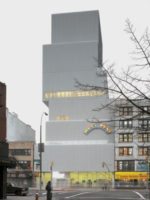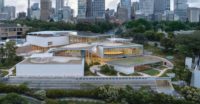For an hour or so yesterday, I was a lab rat in an experiment by artist Carsten Höller. As I sat down on the mirrored carnival swings installed in Carsten Höller: Experience, an exhibition of his work at Manhattan's New Museum, and began to spin very slowly, I became self-consciously aware that my carousel ride was as much for the entertainment of the other visitors as my own. A mobile of suspended cages housing live canaries in the same gallery not-so-subtly drove the point home.
The awkward shift from being the viewer to being the exhibit happens in much of the Brussels-born artist’s work, which combines physical disorientation and play with the dynamics of behavioral research and a healthy dose of spectacle. Witness Giant Psycho Tank (1999), which dares visitors to undress, step into a plastic tank raised about a few feet from the gallery floor, and float alongside similarly prone strangers in a sensory-depriving pool of salt water warmed to amniotic temperatures. With it and other installations, Höller transforms the museum’s white-cubes into a laboratory—albeit one without an identifiable research objective. It’s no surprise to learn that he earned a PhD in agricultural science, studying insect communication, before turning full-time to art. His work cleverly activates the social dynamics of the gallery, but in a way that elicits self-awareness rather than interactions with others—everyone else is just there to remind you that you're being watched.
Perhaps the most dramatic inversion of the typical museum experience, however, is Untitled (Slide) (2011), which directly intervenes in the museum’s building, designed by Pritzker laureates Kazuyo Sejima and Ryue Nishizawa of Tokyo-based SANAA and completed in 2007. An iteration of a piece executed by Höller in several other venues—most sensationally at the Tate Modern’s Turbine Hall in London in 2006—Untitled (Slide) is a steel tube that protrudes through the concrete floor of the museum’s fourth floor and drops in a steep twist through the third floor to a landing area on the second. As visitors slide down the chute, they are examined by their peers through Plexi windows lining sections of the tube, before being deposited among fluorescent sculptures of fatigued-looking animals that look like some combination of a natural history exhibit, outsized toys, and beached whales. Disoriented from the two-story drop, and dazed by the flashing stripes of white neon that illuminate the space, one can’t help but feel camaraderie with the day-glo specimens.
Although the ride takes a few seconds, the slide’s installation was no small feat. The museum cut through two of its nine-inch concrete floor slabs and metal decks to insert it, consulting with Gensler’s New York office, which served as executive architect for the building, and engineers Simpson Gumpertz & Heger. According to the museum’s deputy director, John Hatfield, the process involved taking x-rays of the floors to determine the best insertion points, adjusting the twist of the slide to fit, and severing some electrical wiring while drilling through the concrete. The intervention took just a couple of months to permit and execute, and the floors will be restored immediately after the exhibition closes on January 15. But in the show, two Pyrex-looking glass models and a section drawing—for a skyscraper complex and a house, both with spaces connected by a nest of similar slides—allude to bigger possibilities.
Höller’s experiments can begin to seem one-note or even shallow as you become accustomed to the self-awareness they provoke, but most are cunning and giddily effective. Tucked in an alcove in the four-foot-wide stair leading between the third and fourth floors, Höller has placed a water cooler next to a pile of unlabeled white gel-caps. As another visitor and I contemplated whether we were meant to swallow the unidentified drug, we jumped when an unseen mechanical device above dropped another few pills into the pile. I felt uncomfortably like I was navigating a laboratory maze as I scurried up SANAA’s notoriously narrow stair.
Carsten Höller: Experience is on view at the New Museum in New York City, October 26, 2011 — January 15, 2012.










































